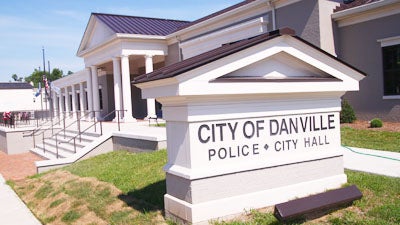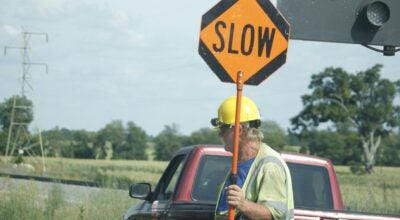Danville Schools have two health programs to choose from
Published 7:31 pm Wednesday, April 17, 2019
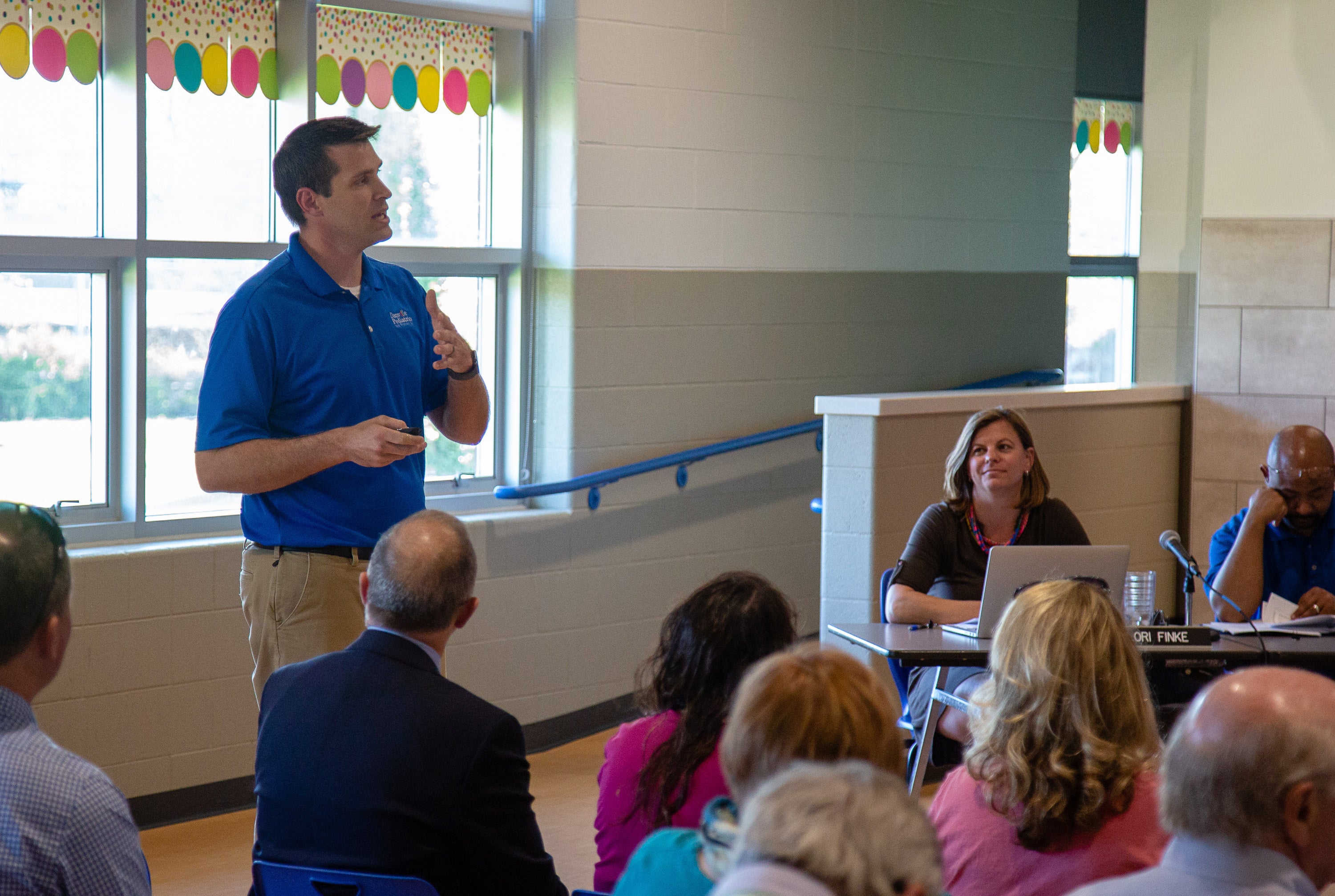
- Dr. Josh Wigglesworth presents a plan for Danville Pediatrics to provide health care services in the Danville Independent School District Tuesday night. Photo by Ben Kleppinger.
The Danville Board of Education now has two different school health program proposals to choose from, both of which would double the number of school nurses and make medical, dental and mental health care available to students.
Danville Pediatrics and Healthy Kids Clinic both gave their pitches to the school board Tuesday night on what they had to offer.
Josh Wiglesworth, a doctor at Danville Pediatrics, told board members his practice, which is owned by five board-certified pediatricians, is already the “medical home” for “the vast majority” of children in the area, including many students in the Danville Independent School District.
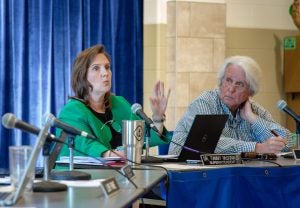
Danville Superintendent Tammy McDonald asks questions during health care presentations to the Danville school board Tuesday night. Photo by Ben Kleppinger.
The practice has more than 5,000 patients who are school-aged children with addresses in the Danville zip code, Wiglesworth said.
“Based upon those numbers, we suspect that 90 percent of students enrolled in any school within the Boyle County area are our patients, and we can say without a doubt that the majority of students here in Danville’s school district have a medical home at Danville Pediatrics,” he said.
Danville Pediatrics asked for a chance to present a proposal for a community-based school health clinic after Healthy Kids Clinic, a program run by Cumberland Family Medical Center, presented a proposal to the Danville school board in March.
Wiglesworth said Danville Pediatrics partnered with Ephraim McDowell Regional Medical Center, Danville Pediatric Dentistry and Webster Orthodontics to come up with a clinic program he said would put Danville Schools head and shoulders above most other school districts in the state in terms of health care services offered to students.
The proposal includes:
- Danville Pediatrics and Ephraim McDowell would hire a nurse coordinator and a licensed practical nurse (LPN), rounding out the number of school nurses in the district to four;
- Danville Pediatrics would “send a medical provider to the Danville Schools each day to see sick children;”
- Ephraim McDowell would provide a licensed clinical social worker to provide mental health care for students on a full-time basis;
- Danville Pediatric Dentistry would provide “dental care, screenings and cleanings to children in the district;”
- Webster Orthodontics would offer “a percentage of children in need of orthodontics care each year without insurance … free braces” and free orthodontic care associated with braces; and
- teachers and staff would be offered health care options through Ephraim McDowell.
Wiglesworth said all students would be provided well child visits every year. And students and their parents would gain access to Danville Pediatrics’ 24/7 “uninterrupted coverage,” meaning they can access a doctor during regular hours or call for help after-hours. This access would be available year-round and outside of regular school hours, he said.
Students who are uninsured would be provided a health care card that would provide “unprecedented continuous pediatric expert health care access at little to no cost,” according to the proposal.
“On Danville Pediatric working days when school is not in session, we will set aside a time so that children with an active card can walk-in and be evaluated by a skilled pediatric provider for only $10,” the proposal reads.
Wiglesworth said because so many Danville students already go to Danville Pediatrics, the doctors they would see if they get sick at school would be the same ones they see on visits outside of school. And there would be no issues with continuity of medical records, because Danville Pediatrics would maintain them across school and office visits.
“A clinic run by Danville Pediatrics, where already 90 percent of the parents of these children have chosen Danville Pediatrics, is going to be a clinic that’s going to be utilized well,” Wiglesworth said. “A clinic not run by Danville Pediatrics when their parents have chosen Danville Pediatrics — I don’t know how that works.”
Wiglesworth said bringing in an outside provider for an in-school medical clinic has the potential to undermine the strong levels of local health care professionals that Danville and Boyle County currently have. He showed graphics from the Robert Wood Johnson Foundation for nearby counties where there are in-school clinics, showing that the number of doctors has gone down relative to the population. In Boyle County, by contrast, there are more doctors per 1,000 people than the state and national averages, and it has remained that way consistently for years.
“I would not take this care for granted,” he said, noting that Danville Pediatrics has been in the community for 42 years. “But the only thing that holds that together is the primary care physicians and the pediatricians in this community who have said, ‘this is the kind of care we’re going to provide.’ … If we’re not there to hold that system together, this community could be like every other community and be a stop-through on your way to Lexington.”
Superintendent Tammy McDonald asked Wiglesworth for assurances that the Danville Pediatrics proposal would include a medical professional who was in the district’s schools every day from open to close, because the proposal wasn’t explicit that would be the case. Wiglesworth said that while it may be different people assigned to cover the schools on different days, someone would be scheduled to be at the schools to see sick children.
McDonald said the district looked at its own records to see how many of its students already use Danville Pediatrics, how many see other pediatricians and how many have no primary care provider. The stats broke down as follows:
- Hogsett Primary School: 66 percent use Danville Pediatrics; 9 percent have no primary care provider.
- Toliver Intermediate School: 59 percent use Danville Pediatrics; 12 percent have no PCP.
- Bate Middle School: 57 percent use Danville Pediatrics; 11 percent have no PCP.
- Danville High School: 44 percent use Danville Pediatrics; 14 percent have no PCP.
Wiglesworth said he believes if you were to look at “who signed their vaccine records,” the percentage who use Danville Pediatrics would be much higher.
Wiglesworth said Danville Pediatrics would prefer to provide vaccines and immunizations in their offices, but it may be possible to provide flu shots in the schools. Similarly, Danville Pediatric Dentistry would prefer to see students in their offices, but could setup in-school to provide some dental care.
McDonald noted one reason the school district began looking into health care options was to provide health care services to students at school, because many students in the district come from families for whom transportation is a significant obstacle.
Healthy Kids Clinic
Ibby Hopper presented what Healthy Kids Clinic could offer, as she did last month before the school district knew Danville Pediatrics was interested in providing services.
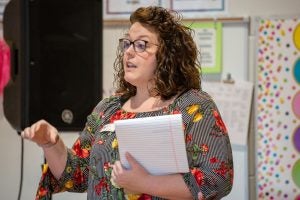
Abby Hopper with Healthy Kids Clinic tells Danville school board members what HKC can offer the district as far as health care services in the schools. Photo by Ben Kleppinger.
Hopper said Healthy Kids Clinic is successfully operating 87 in-school clinics across 14 school districts. It requires permission from the Kentucky Department of Education to provide health care inside a school, which Healthy Kids Clinic has worked to obtain, she said.
In its first year in the Danville Schools, HKC would provide 51 percent of the salaries and benefits for four nurses, essentially paying for two more than the two Danville has now, she said.
HKC would be transparent with the school district about the finances of the program, and if they show a profit, they could increase the percentage they pay of the nurses’ salaries and benefits in future years.
HKC would also provide a nurse practitioner to see sick kids in the schools every day. And it would optionally provide a behavioral health professional such as a licensed clinical social worker and dental services for students in the schools at no cost.
HKC would provide behavioral health training to school staff so that teachers could spot signs that a student might need counseling and pay for all supplies needed at the nurses’ stations, Hopper said.
As far as working with students’ primary care physicians, Hopper said HKC is starting up a new program this year allowing it to inform PCPs on the day a child is seen by HKC of the visit and what happened.
“We value patient-centered medical homes and having a medical provider,” she said. “We truly value that care and that continuation of care. We are glad to work with the community partners.”
If HKC performs a well child visit in the schools and then a student’s PCP performs a well child visit as well, Hopper said HKC would back out their charge to insurance so the PCP could get paid instead.
HKC uses a “sliding fee scale program,” which charges $10, $20 or $30 for a sick child to be seen by a provider, and there’s also a hardship policy for those that can’t afford even $10, allowing them to be seen for free, Hopper said.
Hopper closed her presentation by telling board members, “I am not here to try to sell you our services.”
“I appreciate you all letting me come and talk to you. If you choose to go with us, that is wonderful. If you choose not to, that’s OK, too,” she said. “If you can get services for the kids in Danville, that’s all that matters to us.”
McDonald said she would come back to board members at their regular meeting next week with analysis of both proposals, including pros and cons. The board meets Monday at 6 p.m. at Danville High School.
This story has been corrected to reflect the correct spelling of Josh Wiglesworth’s name.



